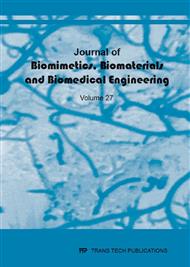[1]
F. Migliavacca, L. Petrini,V. Montanari,I. Quagliana, F. Auricchio, G. Dubini, A predictive study of the mechanical behaviour of coronary stents by computer modelling, Medical Engineering & Physics 27 (2005) 13-18.
DOI: 10.1016/j.medengphy.2004.08.012
Google Scholar
[2]
F. Migliavacca, L. Petrini, M. Colombo, F. Auricchio, R. Pietrabissa, Mechanical behavior of coronary stents investigated through the finite element method, Journal of Biomechanics 35 (2002) 803-811.
DOI: 10.1016/s0021-9290(02)00033-7
Google Scholar
[3]
M.R. Bennet, M. O'Sullivan, Mechanisms of angioplasty and stent restenosis: implications for design of rational therapy, Pharmacology & Therapeutics 91 (2001) 149-166.
DOI: 10.1016/s0163-7258(01)00153-x
Google Scholar
[4]
S. Schievano, G. Parenzan, F. Migliavacca, L. Petrini, G. Dubini, P. Bonheeffer, Stent fracture in percutaneous pulmonary valve implantation: a finite element study, Journal of Biomechanics 39 (2006) 292-293.
DOI: 10.1016/s0021-9290(06)84134-5
Google Scholar
[5]
C.A. Sweeney, P.E. McHugh, J.P. McGarry, S.B. Leen, Micromechanical methodology for fatigue in cardiovascular stents, International Journal of Fatigue 44 (2012) 202-216.
DOI: 10.1016/j.ijfatigue.2012.04.022
Google Scholar
[6]
M. Azaouzi, A. Makradi, J. Petit, S. Belouettar, O. Polit, On the numerical investigation of cardiovascular balloon-expandable stent using finite element method, Computational Materials Science 79 (2013) 326-335.
DOI: 10.1016/j.commatsci.2013.05.043
Google Scholar
[7]
F. Shaikh, R. Maddikunta, M. Djelmami-Hani, J. Solis, S. Allaqaband, T. Bajwa, Stent fracture, an incidental finding or a significant marker of clinical in-stent restenosis? Catheterization and Cardiovascular Interventions 71 (2008) 614-618.
DOI: 10.1002/ccd.21371
Google Scholar
[8]
G. Sianos, S. Hofma, J.M.R. Ligthart, F. Saia, A. Hoye, P.A. Lemos, P.W. Serruys, Stent fracture and restenosis in the drug-eluting stent era, Catheterization and Cardiovascular Interventions 61 (2004) 111-116.
DOI: 10.1002/ccd.10709
Google Scholar
[9]
C. Lallya, F. Dolanb, P.J. Prendergast, Cardiovascular stent design and vessel stresses: a finite element analysis, Journal of Biomechanics 38 (2005) 1574–1581.
DOI: 10.1016/j.jbiomech.2004.07.022
Google Scholar
[10]
ABAQUS/Standard. Documentation for version 6. 11. Dassault System Simulia.
Google Scholar
[11]
G.A. Holzapfel, G. Sommer, C.T. Gasser, P. Regitnig, Determination of layer-specific mechanical properties of human coronary arteries with nonatherosclerotic intimal thickening and related constitutive modeling, Journal of Biomechanics 289 (2005).
DOI: 10.1152/ajpheart.00934.2004
Google Scholar
[12]
K.S. Matthys, J. Alastruey, J. Peiro, A.W. Khir, P. Segers, P.R. Verdonck, K.H. Parker, S.J. Sherwin, Pulse wave propagation in a model human arterial network: Assessment of 1-D numerical simulations against in vitro measurements, Journal of Biomechanics 40 (2007).
DOI: 10.1016/j.jbiomech.2007.05.027
Google Scholar
[13]
K. Dang Van, Macro-micro approach in high-cycle multiaxial fatigue. In: D.L. McDowell, R. Ellis, editors. Advances in multi-axial fatigue. ASTM, (1993) 120-130.
DOI: 10.1520/stp24799s
Google Scholar
[14]
W.N. Findley, Fatigue of metals under combination of stresses, Transaction of the American Society of Mechanical Engineers 79 (1957) 1337-1348.
Google Scholar
[15]
J. Goodman, Mechanics applied to engineering, Longmans, Greens and Company, London (1914).
Google Scholar
[16]
S. Wiersma, F. Dolan, D. Taylor, Fatigue and fracture in materials used for micro-scale biomedical components, Biomedical Materials Engineering 16 (2006) 137-146.
Google Scholar
[17]
A. Chamat, M. Abbadi, J. Gilgert, F. Cocheteux, Z. Azari, A new non-local criterion in high-cycle multiaxial fatigue for non-proportional loadings, International Journal of Fatigue 29 (2007) 1465-1474.
DOI: 10.1016/j.ijfatigue.2006.10.033
Google Scholar
[18]
G.D. Dangas, B.E. Claessen, A. Caixeta, E.A. Sanidas, G.S. Mintz, R. Mehran, In-stent restenosis in the drug-eluting stent era, Journal of the American College of Cardiology, 56 (2010) 1897-(1907).
DOI: 10.1016/j.jacc.2010.07.028
Google Scholar
[19]
M.R. Bennett, In-stent stenosis: Pathology and implications for the development of drug eluting stents, Heart 89 (2003) 218-224.
DOI: 10.1136/heart.89.2.218
Google Scholar
[20]
H. Hamid, J. Coltart, Miracle stents – a future without restenosis, McGill Journal of Medicine 10 (2007) 105-111.
DOI: 10.26443/mjm.v10i2.446
Google Scholar
[21]
N. Labropoulos, M. Borge, K. Pierce, P.J. Pappas, Criteria for defining significant central vein stenosis with duplex ultrasound, Journal of Vascular Surgery 46 (2007) 101-107.
DOI: 10.1016/j.jvs.2007.02.062
Google Scholar
[22]
A.H. Mahnken, CT imaging of coronary stents: Past, present, and future, ISRN Cardiology 2012 (2012) 1-12.
DOI: 10.5402/2012/139823
Google Scholar
[23]
R.E. Kuntz, R.D. Safian, J.P. Carrozza,. R.F. Fishman,. M. Mansour, D.S. Baim, The importance of acute luminal diameter in determining restenosis after coronary atherectomy or stenting, Circulation 86 (1992) 1827-1835.
DOI: 10.1161/01.cir.86.6.1827
Google Scholar
[24]
A. Wang, R.A. Krasuski, J.J. Warner, K. Pieper, K.B. Kisslo, T.M. Bashore, J.K. Harrison, Serial echocardigraphic evaluation of restenosis after successful percutaneous mitral commissurotomy, Journal of the American College of Cardiology, 39 (2002).
DOI: 10.1016/s0735-1097(01)01726-0
Google Scholar
[25]
B.F. Waller, The eccentric coronary atherosclerotic plaque: Morphologic observations and clinical relevance, Clinical Cardiology, 12 (1989) 14-20.
DOI: 10.1002/clc.4960120103
Google Scholar


